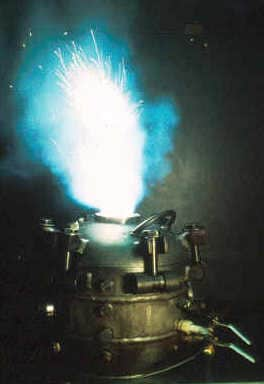Mining Topic: Lasers
What is the health and safety problem?
The Pittsburgh Mining Research Division (PMRD) strives to reduce adverse safety consequences in the mining industry through effective interventions with new technologies. To this end. laser technologies are being developed for a variety of applications. In the coal mining industry, lasers can be used to detect the presence of dangerous gases, to monitor the level of coal in storage facilities, and to survey the underground mine, just to name a few. However, lasers must not pose an ignition hazard when used in potentially flammable environments found in underground mines and surface facilities. This leads to the question—just how powerful does a laser beam need to be before it can cause an explosion?
What is the extent of the problem?
The rapid development of laser technologies has prompted international efforts to establish safety guidelines for the use of laser-based equipment in potentially explosive environments. Researchers from a number of countries participate with the International Electrotechnical Commission (IEC) 60079-28 Maintenance Team to develop Risk of Ignition by Radiation from Optical Equipment guidelines. Safety guidelines are needed due to the risk of fires and explosions in the presence of methane and coal dust. For instance, lasers could cause smoldering in coal dust layers, leading to the possibility of large-scale burning.
How is the NIOSH Mining program addressing this problem?

Ignition tests were conducted in a 20 liter chamber that contained the explosions.
PMRD researchers have taken an experimental approach to help reduce the risk of ignition by lasers used in potentially explosive environments. Researchers conducted over 1,000 ignition experiments with powerful lasers, studying several variables that can contribute to an explosion. Ignition tests were conducted in a 20-liter chamber that contained the explosions. Explosive concentrations of methane gas or coal dust clouds were put into the chamber. The laser beam was then directed into the chamber using fiber optic cables. If the test resulted in an explosion, the laser power was reduced and the experiment was repeated. The series of tests continued until the laser beam was not powerful enough to ignite the methane or coal dust. Many such series were repeated to study the effect of gas concentration, beam size, and other variables on ignitability.
What are the significant findings?
Laser ignition power thresholds for methane and coal dust were measured. Limiting the laser power to levels below the thresholds will minimize the risk of ignition. Researchers observed that the amount of laser power needed to create explosions was proportional to the laser beam diameter. This suggests that explosions could be prevented even for relatively powerful beams by ensuring that the beam diameter is large enough to reduce the beam intensity. Researchers also measured the time delays for producing laser ignitions, which can be used for designing automatic safety shutoffs. Using these findings, researchers demonstrated the effectiveness of a commercial fiber optic power limiter for preventing ignitions.
What are the next steps?
Results of the work by PMRD researchers are referenced in the International Electrotechnical Commission standard IEC 60079-28 Explosive atmospheres—Part 28: Protection of equipment and transmission systems using optical radiation.
- A Centennial of Mine Explosion Prevention Research
- Coal Dust and Methane
- Coal Mine Explosion Prevention
- Continuous Wave Laser Ignition Thresholds of Coal Dust Clouds
- Distributed Measurement of Conductor Temperatures in Mine Trailing Cables Using Fiber-Optic Technology
- The Explosibility of Coal Dust
- Explosion Prevention in United States Coal Mines
- A Fail-Safe Control System for a Mine Methane Pipeline
- Ignition of Hydraulic Fluid Sprays by Open Flames and Hot Surfaces
- Ignition of Methane-Air Mixtures by Laser Heated Small Particles
- Ignition Tests With a Fiber-Optic Powered Instrument
- Laser Ignition of Flammable Gas
- Lightning Propagation Through the Earth and its Potential for Methane Ignitions in Abandoned Areas of Underground Coal Mines
- Methane-Air Mixtures Ignited by CW Laser-Heated Targets on Optical Fiber Tips: Comparison of Targets, Optical Fibers, and Ignition Delays
- NIOSH Research for Monitoring and Controlling Methane at U.S. Underground Coal Mining Operations
- Optically Powered Remote Gas Monitor
- Remote Fiber-Optic Methane Monitor
- Technology News 530 - Frictional Ignition of Methane-Air in the Presence of Liquid Hydrocarbons
- Threshold Powers and Delays for Igniting Propane and Butane-Air Mixtures by CW Laser-heated Small Particles